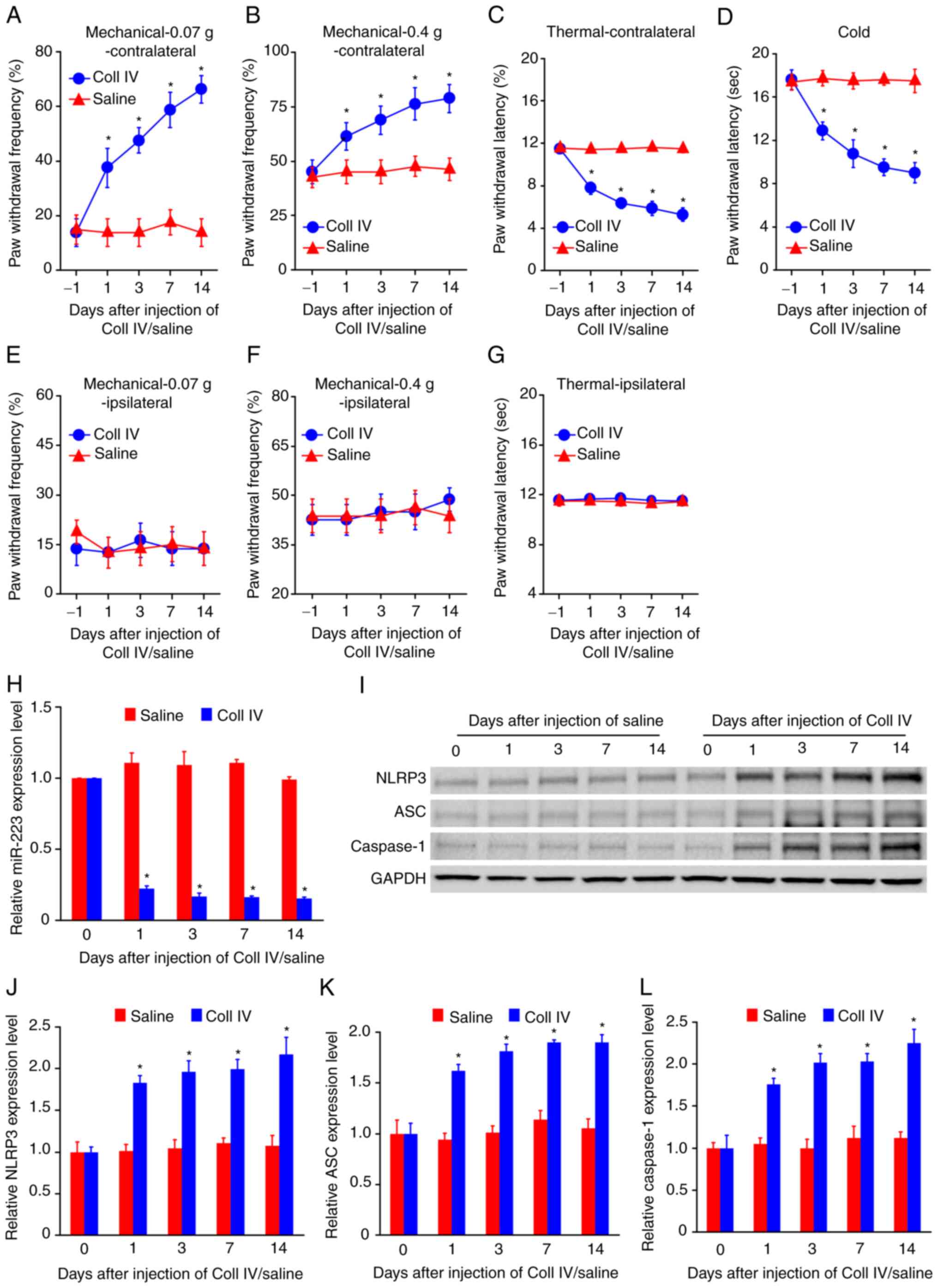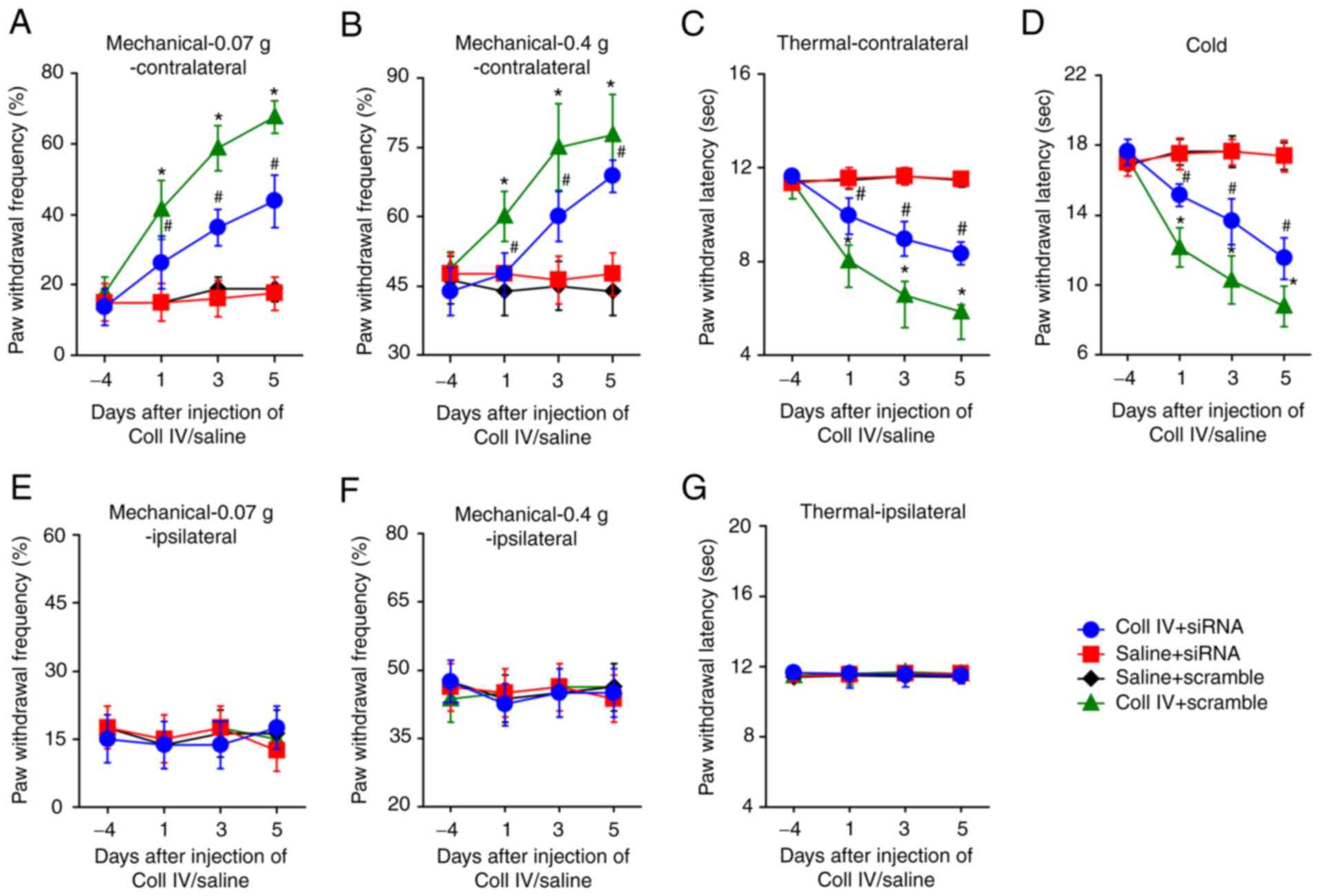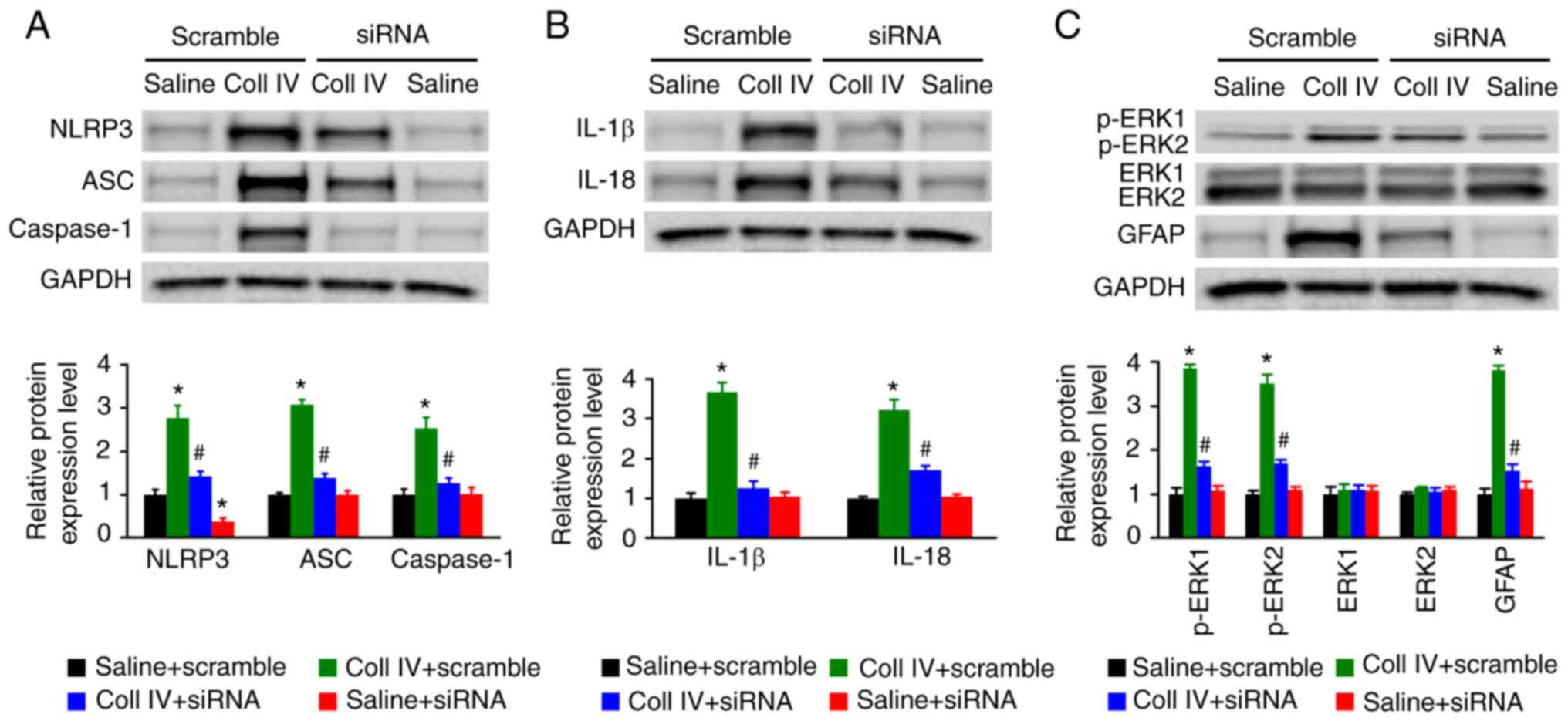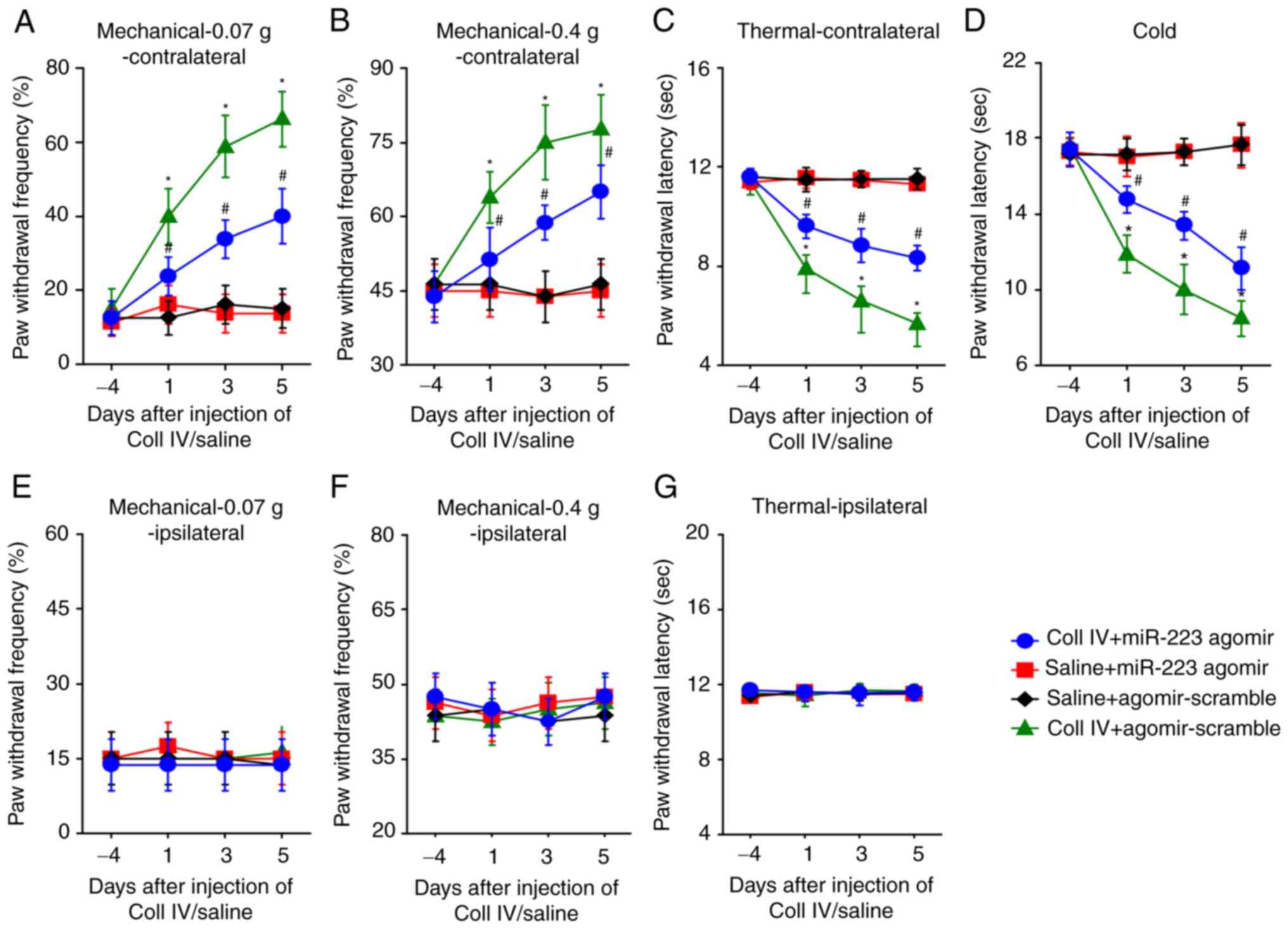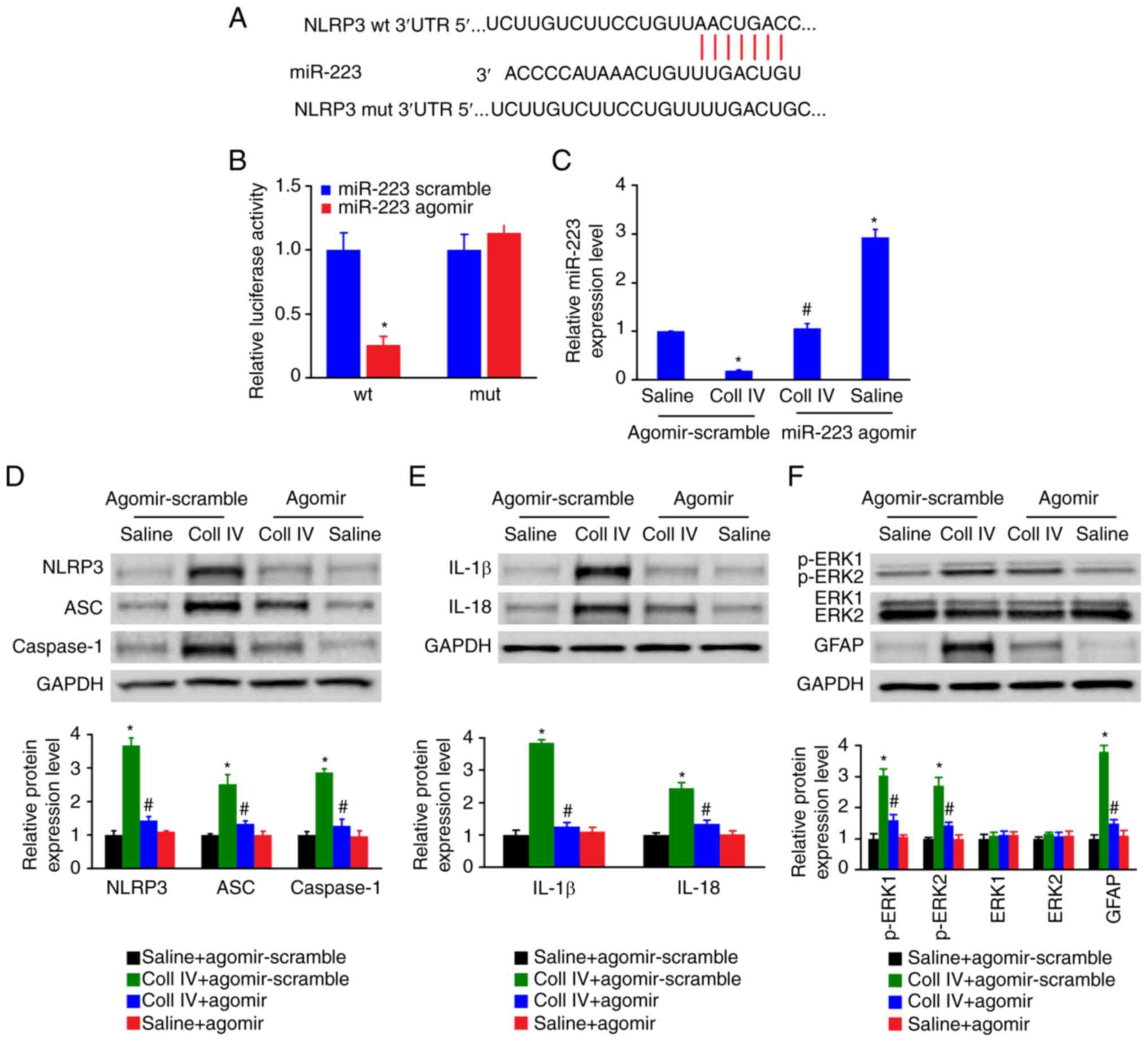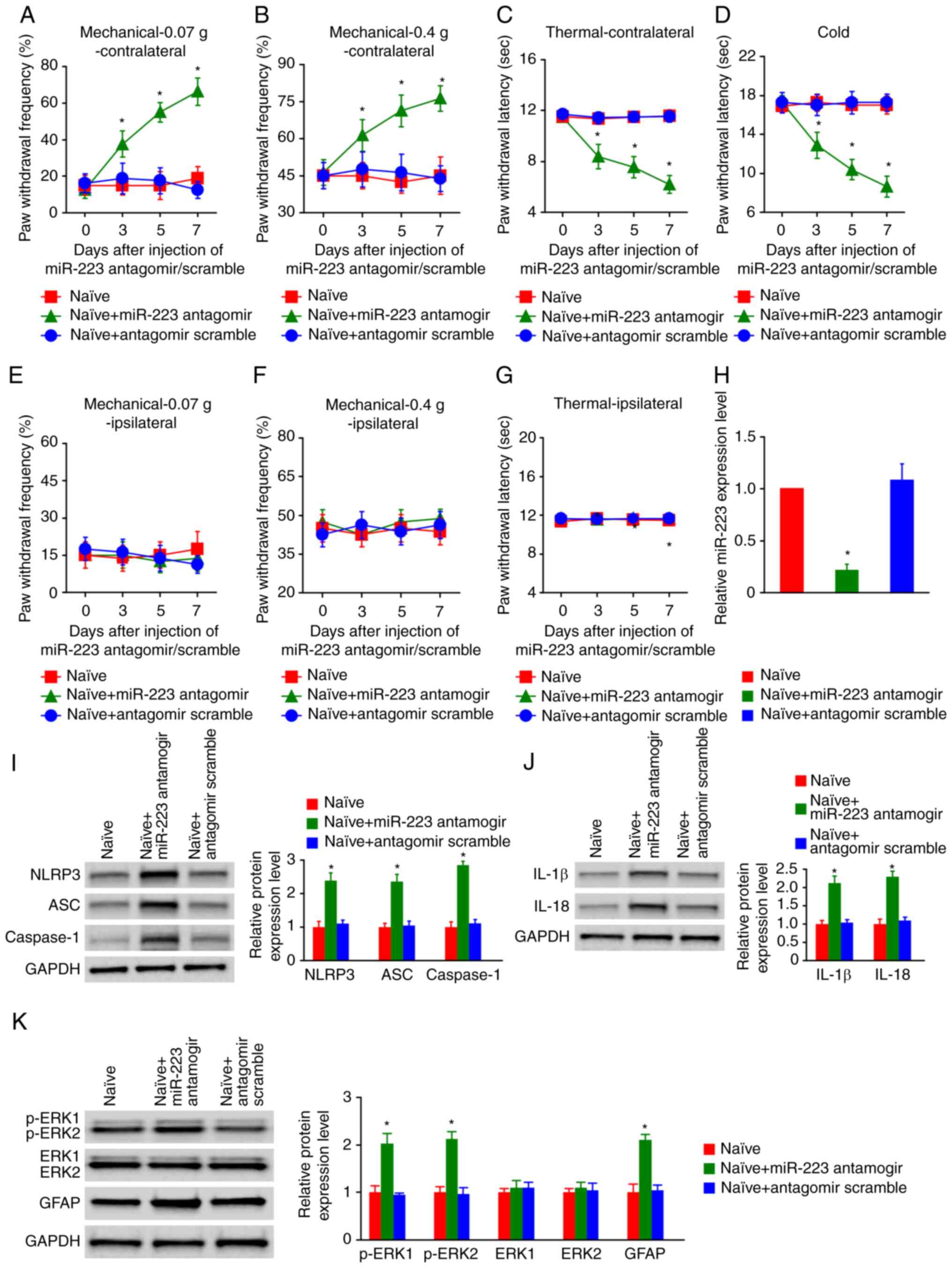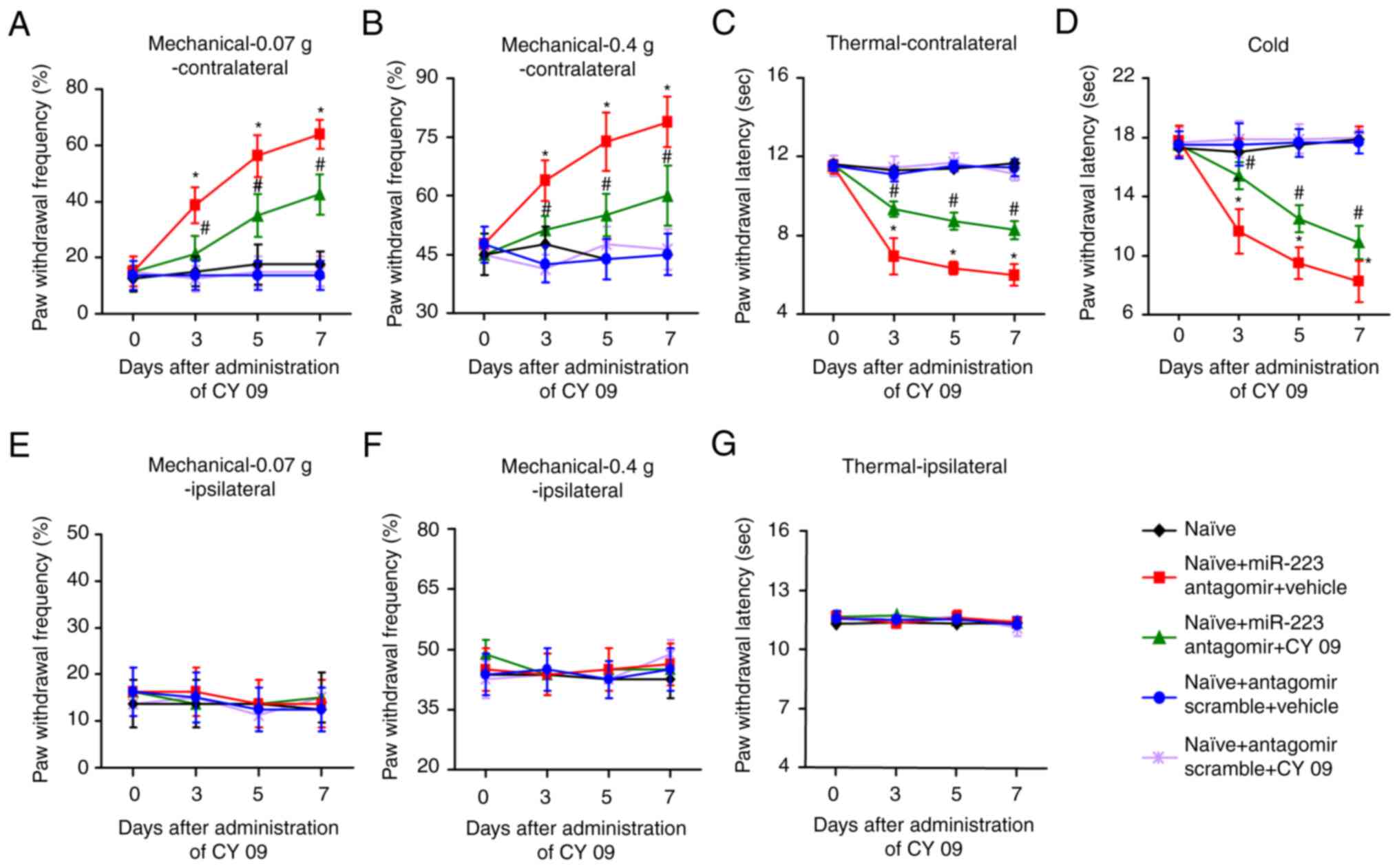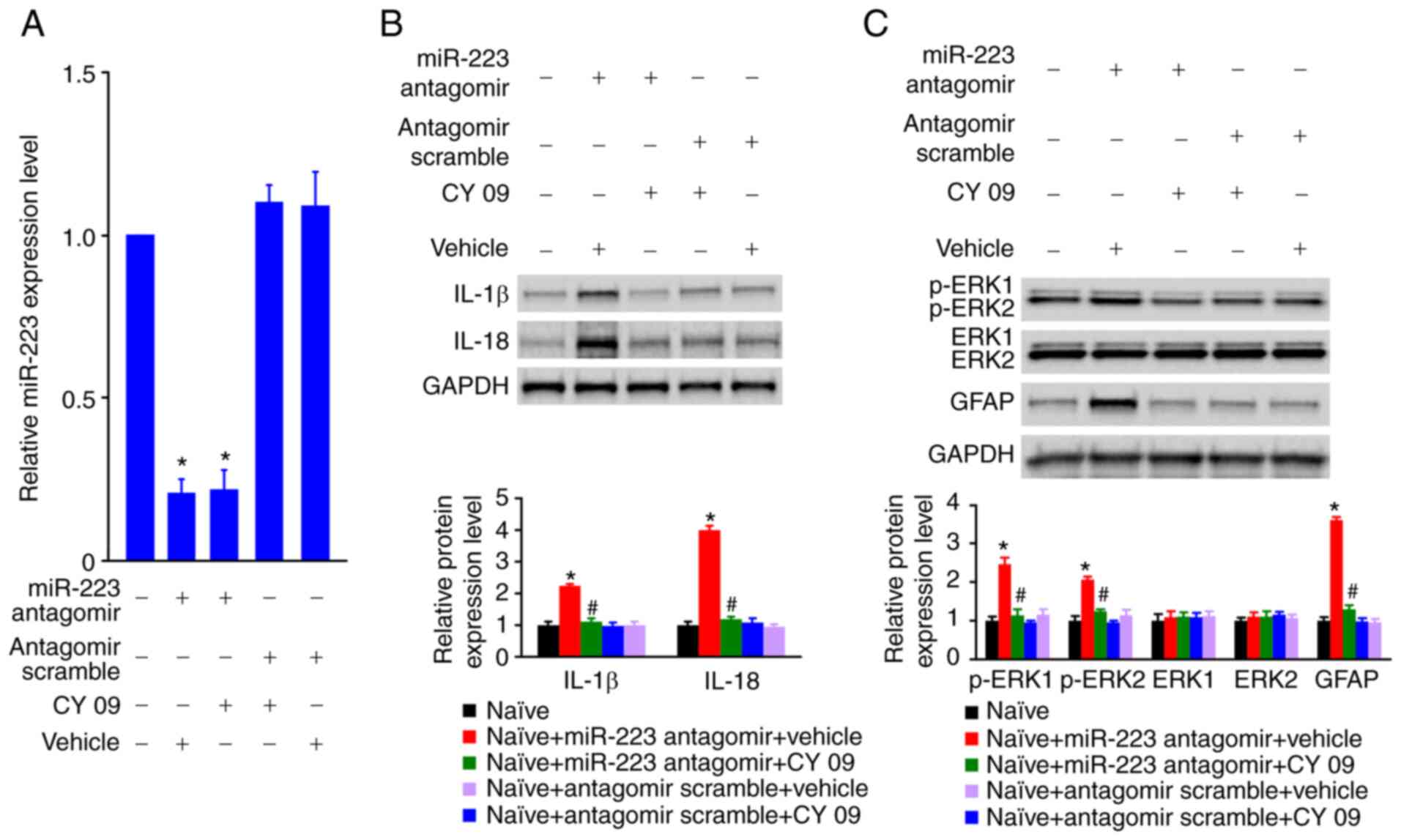|
1
|
Maida CD, Norrito RL, Daidone M,
Tuttolomondo A and Pinto A: Neuroinflammatory mechanisms in
ischemic stroke: Focus on cardioembolic stroke, background, and
therapeutic approaches. Int J Mol Sci. 21(6454)2020.PubMed/NCBI View Article : Google Scholar
|
|
2
|
Paolucci S, Iosa M, Toni D, Barbanti P,
Bovi P, Cavallini A, Candeloro E, Mancini A, Mancuso M, Monaco S,
et al: Prevalence and time course of post-stroke pain: A
multicenter prospective hospital-based study. Pain Med. 17:924–930.
2016.PubMed/NCBI View Article : Google Scholar
|
|
3
|
Harrison RA and Field TS: Post stroke
pain: Identification, assessment, and therapy. Cerebrovasc Dis.
39:190–201. 2015.PubMed/NCBI View Article : Google Scholar
|
|
4
|
Klit H, Finnerup NB and Jensen TS: Central
post-stroke pain: Clinical characteristics, pathophysiology, and
management. Lancet Neurol. 8:857–868. 2009.PubMed/NCBI View Article : Google Scholar
|
|
5
|
Vukojevic Z, Dominovic Kovacevic A, Peric
S, Grgic S, Bjelica B, Basta I and Lavrnic D: Frequency and
features of the central poststroke pain. J Neurol Sci. 391:100–103.
2018.PubMed/NCBI View Article : Google Scholar
|
|
6
|
Feigin VL, Lawes CM, Bennett DA and
Anderson CS: Stroke epidemiology: A review of population-based
studies of incidence, prevalence, and case-fatality in the late
20th century. Lancet Neurol. 2:43–53. 2003.PubMed/NCBI View Article : Google Scholar
|
|
7
|
Kumar G and Soni CR: Central post-stroke
pain: Current evidence. J Neurol Sci. 284:10–17. 2009.PubMed/NCBI View Article : Google Scholar
|
|
8
|
Kumar B, Kalita J, Kumar G and Misra UK:
Central poststroke pain: A review of pathophysiology and treatment.
Anesth Analg. 108:1645–1657. 2009.PubMed/NCBI View Article : Google Scholar
|
|
9
|
Martinon F, Burns K and Tschopp J: The
inflammasome: A molecular platform triggering activation of
inflammatory caspases and processing of proIL-beta. Mol Cell.
10:417–426. 2002.PubMed/NCBI View Article : Google Scholar
|
|
10
|
Huang Y, Xu W and Zhou R: NLRP3
inflammasome activation and cell death. Cell Mol Immunol.
18:2114–2127. 2021.PubMed/NCBI View Article : Google Scholar
|
|
11
|
Leemans JC, Cassel SL and Sutterwala FS:
Sensing damage by the NLRP3 inflammasome. Immunol Rev. 243:152–162.
2011.PubMed/NCBI View Article : Google Scholar
|
|
12
|
Li WW, Guo TZ, Liang D, Shi X, Wei T,
Kingery WS and Clark DJ: The NALP1 inflammasome controls cytokine
production and nociception in a rat fracture model of complex
regional pain syndrome. Pain. 147:277–286. 2009.PubMed/NCBI View Article : Google Scholar
|
|
13
|
Chen L, Li X, Huang L, Wu Q, Chen L and
Wan Q: Chemical stimulation of the intracranial dura activates
NALP3 inflammasome in trigeminal ganglia neurons. Brain Res.
1566:1–11. 2014.PubMed/NCBI View Article : Google Scholar
|
|
14
|
Smith HS, Bracken D and Smith JM: Gout:
Current insights and future perspectives. J Pain. 12:1113–1129.
2011.PubMed/NCBI View Article : Google Scholar
|
|
15
|
Zhang A, Wang K, Ding L, Bao X, Wang X,
Qiu X and Liu J: Bay11-7082 attenuates neuropathic pain via
inhibition of nuclear factor-kappa B and nucleotide-binding
domain-like receptor protein 3 inflammasome activation in dorsal
root ganglions in a rat model of lumbar disc herniation. J Pain
Res. 10:375–382. 2017.PubMed/NCBI View Article : Google Scholar
|
|
16
|
Qian J, Zhu W, Lu M, Ni B and Yang J:
D-β-hydroxybutyrate promotes functional recovery and relieves pain
hypersensitivity in mice with spinal cord injury. Br J Pharmacol.
174:1961–1971. 2017.PubMed/NCBI View Article : Google Scholar
|
|
17
|
Liu J: Control of protein synthesis and
mRNA degradation by microRNAs. Curr Opin Cell Biol. 20:214–221.
2008.PubMed/NCBI View Article : Google Scholar
|
|
18
|
Sakai A, Saitow F, Miyake N, Miyake K,
Shimada T and Suzuki H: miR-7a alleviates the maintenance of
neuropathic pain through regulation of neuronal excitability.
Brain. 136:2738–2750. 2013.PubMed/NCBI View Article : Google Scholar
|
|
19
|
Leinders M, Üçeyler N, Pritchard RA,
Sommer C and Sorkin LS: Increased miR-132-3p expression is
associated with chronic neuropathic pain. Exp Neurol. 283:276–286.
2016.PubMed/NCBI View Article : Google Scholar
|
|
20
|
Gilicze AB, Wiener Z, Tóth S, Buzás E,
Pállinger É, Falcone FH and Falus A: Myeloid-derived microRNAs,
miR-223, miR27a, and miR-652, are dominant players in myeloid
regulation. BioMed Res Int. 2014(870267)2014.PubMed/NCBI View Article : Google Scholar
|
|
21
|
Wang J, Bai X, Song Q, Fan F, Hu Z, Cheng
G and Zhang Y: miR-223 inhibits lipid deposition and inflammation
by suppressing toll-like receptor 4 signaling in macrophages. Int J
Mol Sci. 16:24965–24982. 2015.PubMed/NCBI View Article : Google Scholar
|
|
22
|
Cardoso AL, Guedes JR and de Lima MC: Role
of microRNAs in the regulation of innate immune cells under
neuroinflammatory conditions. Curr Opin Pharmacol. 26:1–9.
2016.PubMed/NCBI View Article : Google Scholar
|
|
23
|
Bauernfeind F, Rieger A, Schildberg FA,
Knolle PA, Schmid-Burgk JL and Hornung V: NLRP3 inflammasome
activity is negatively controlled by miR-223. J Immunol.
189:4175–4181. 2012.PubMed/NCBI View Article : Google Scholar
|
|
24
|
Haneklaus M, Gerlic M, Kurowska-Stolarska
M, Rainey AA, Pich D, McInnes IB, Hammerschmidt W, O'Neill LA and
Masters SL: Cutting edge: miR-223 and EBV miR-BART15 regulate the
NLRP3 inflammasome and il-1β production. J Immunol.
189(3795-3795-3799)2012.PubMed/NCBI View Article : Google Scholar
|
|
25
|
General Administration of Quality
Supervision, Inspection and Quarantine of the People's Republic of
China, Standardization Administration of China. Laboratory animal -
Requirements of environment and housing facilities GB
14925-2010[S]. China Quality Inspection Press, Beijing, pp1-18,
2010.
|
|
26
|
Zimmermann M: Ethical guidelines for
investigations of experimental pain in conscious animals. Pain.
16:109–110. 1983.PubMed/NCBI View Article : Google Scholar
|
|
27
|
Cai W, Wu S, Pan Z, Xiao J, Li F, Cao J,
Zang W and Tao YX: Disrupting interaction of PSD-95 with nNOS
attenuates hemorrhage-induced thalamic pain. Neuropharmacology.
141:238–248. 2018.PubMed/NCBI View Article : Google Scholar
|
|
28
|
Li Z, Mao Y, Liang L, Wu S, Yuan J, Mo K,
Cai W, Mao Q, Cao J, Bekker A, et al: The transcription factor
C/EBPβ in the dorsal root ganglion contributes to peripheral nerve
trauma-induced nociceptive hypersensitivity. Sci Signal.
10(eaam5345)2017.PubMed/NCBI View Article : Google Scholar
|
|
29
|
Li Z, Gu X, Sun L, Wu S, Liang L, Cao J,
Lutz BM, Bekker A, Zhang W and Tao YX: Dorsal root ganglion myeloid
zinc finger protein 1 contributes to neuropathic pain after
peripheral nerve trauma. Pain. 156:711–721. 2015.PubMed/NCBI View Article : Google Scholar
|
|
30
|
Xu JT, Zhao JY, Zhao X, Ligons D, Tiwari
V, Atianjoh FE, Lee CY, Liang L, Zang W, Njoku D, et al: Opioid
receptor-triggered spinal mTORC1 activation contributes to morphine
tolerance and hyperalgesia. J Clin Investig. 124:592–603.
2014.PubMed/NCBI View
Article : Google Scholar
|
|
31
|
Zhao X, Tang Z, Zhang H, Atianjoh FE, Zhao
JY, Liang L, Wang W, Guan X, Kao SC, Tiwari V, et al: A long
noncoding RNA contributes to neuropathic pain by silencing Kcna2 in
primary afferent neurons. Nat Neurosci. 16:1024–1031.
2013.PubMed/NCBI View
Article : Google Scholar
|
|
32
|
Huang T, Fu G, Gao J, Zhang Y, Cai W, Wu
S, Jia S, Xia S, Bachmann T, Bekker A and Tao YX: Fgr contributes
to hemorrhage-induced thalamic pain by activating NF-κB/ERK1/2
pathways. JCI Insight. 5(e139987)2020.PubMed/NCBI View Article : Google Scholar
|
|
33
|
Fang XZ, Huang TF, Wang CJ, Ge YL, Lin SY,
Zhang Y and Gao J: Preconditioning of physiological cyclic stretch
attenuated HMGB1 expression in pathologically mechanical
stretch-activated A549 cells and ventilator-induced lung injury
rats through inhibition of IL-6/STAT3/SOCS3. Int Immunopharmacol.
31:66–73. 2016.PubMed/NCBI View Article : Google Scholar
|
|
34
|
Zhang Y, Huang T, Jiang L, Gao J, Yu D, Ge
Y and Lin S: MCP-induced protein 1 attenuates sepsis-induced acute
lung injury by modulating macrophage polarization via the JNK/c-Myc
pathway. Int Immunopharmacol. 75(105741)2019.PubMed/NCBI View Article : Google Scholar
|
|
35
|
Livak KJ and Schmittgen TD: Analysis of
relative gene expression data using real-time quantitative PCR and
the 2-(-Delta Delta C(T)) method. Methods. 25:402–408.
2001.PubMed/NCBI View Article : Google Scholar
|
|
36
|
Yu D, Fang X, Xu Y, Xiao H, Huang T, Zhang
Y, Ge Y, Li Y, Zong L and Gao J: Rev-erbα can regulate the
NF-κB/NALP3 pathway to modulate lipopolysaccharide-induced acute
lung injury and inflammation. Int Immunopharmacol. 73:312–320.
2019.PubMed/NCBI View Article : Google Scholar
|
|
37
|
Jiang H, He H, Chen Y, Huang W, Cheng J,
Ye J, Wang A, Tao J, Wang C, Liu Q, et al: Identification of a
selective and direct NLRP3 inhibitor to treat inflammatory
disorders. J Exp Med. 214:3219–3238. 2017.PubMed/NCBI View Article : Google Scholar
|
|
38
|
Yang Y, Yang F, Yang F, Li CL, Wang Y, Li
Z, Lu YF, Yu YQ, Fu H, He T, et al: Gabapentinoid Insensitivity
after Repeated Administration is Associated with Down-Regulation of
the α(2)δ-1 Subunit in rats with central post-stroke pain
hypersensitivity. Neurosci Bull. 32:41–50. 2016.PubMed/NCBI View Article : Google Scholar
|
|
39
|
Wang J: Preclinical and clinical research
on inflammation after intracerebral hemorrhage. Prog Neurobiol.
92:463–477. 2010.PubMed/NCBI View Article : Google Scholar
|
|
40
|
Pan Z, Shan Q, Gu P, Wang XM, Tai LW, Sun
M, Luo X, Sun L and Cheung CW: miRNA-23a/CXCR4 regulates
neuropathic pain via directly targeting TXNIP/NLRP3 inflammasome
axis. J Neuroinflammation. 15(29)2018.PubMed/NCBI View Article : Google Scholar
|
|
41
|
Wang Z, Liu F, Wei M, Qiu Y, Ma C, Shen L
and Huang Y: Chronic constriction injury-induced microRNA-146a-5p
alleviates neuropathic pain through suppression of IRAK1/TRAF6
signaling pathway. J Neuroinflammation. 15(179)2018.PubMed/NCBI View Article : Google Scholar
|
|
42
|
Shi J, Jiang K and Li Z: miR-145
ameliorates neuropathic pain via inhibiting inflammatory responses
and mTOR signaling pathway by targeting Akt3 in a rat model.
Neurosci Res. 134:10–17. 2018.PubMed/NCBI View Article : Google Scholar
|
|
43
|
Shi G, Shi J, Liu K, Liu N, Wang Y, Fu Z,
Ding J, Jia L and Yuan W: Increased miR-195 aggravates neuropathic
pain by inhibiting autophagy following peripheral nerve injury.
Glia. 61:504–512. 2013.PubMed/NCBI View Article : Google Scholar
|
|
44
|
Correction to title, results and
conclusion in. Down-regulated IncRNA F630028O10Rik contributes to
suppress lung cancer in mice through inhibiting miR-223-3p and VEGF
signaling pathway. Chest. 150(261)2016.PubMed/NCBI View Article : Google Scholar
|
|
45
|
Yang F, Xu Y, Liu C, Ma C, Zou S, Xu X,
Jia J and Liu Z: NF-κB/miR-223-3p/ARID1A axis is involved in
Helicobacter pylori CagA-induced gastric carcinogenesis and
progression. Cell Death Dis. 9(12)2018.PubMed/NCBI View Article : Google Scholar
|
|
46
|
Calvente CJ, Tameda M, Johnson CD, del
Pilar H, Lin YC, Adronikou N, De Mollerat Du Jeu X, Llorente C,
Boyer J and Feldstein AE: Neutrophils contribute to spontaneous
resolution of liver inflammation and fibrosis via microRNA-223. J
Clin Investig. 129:4091–4109. 2019.PubMed/NCBI View Article : Google Scholar
|
|
47
|
Cressatti M, Juwara L, Galindez JM, Velly
AM, Nkurunziza ES, Marier S, Canie O, Gornistky M and Schipper HM:
Salivary microR-153 and microR-223 levels as potential diagnostic
biomarkers of idiopathic Parkinson's disease. Mov Disord.
35:468–477. 2019.PubMed/NCBI View Article : Google Scholar
|
|
48
|
Hoffman HM, Mueller JL, Broide DH,
Wanderer AA and Kolodner RD: Mutation of a new gene encoding a
putative pyrin-like protein causes familial cold autoinflammatory
syndrome and Muckle-Wells syndrome. Nat Genet. 29:301–305.
2001.PubMed/NCBI View
Article : Google Scholar
|
|
49
|
Wen H, Ting JP and O'Neill LA: A role for
the NLRP3 inflammasome in metabolic diseases-did Warburg miss
inflammation? Nat Immunol. 13:352–357. 2012.PubMed/NCBI View Article : Google Scholar
|
|
50
|
Liu SB, Mi WL and Wang YQ: Research
progress on the NLRP3 inflammasome and its role in the central
nervous system. Neurosci Bull. 29:779–787. 2013.PubMed/NCBI View Article : Google Scholar
|
|
51
|
Guo S, Yang C, Diao B, Huang X, Jin M,
Chen L, Yan W, Ning Q, Zheng L, Wu Y and Chen Y: The NLRP3
inflammasome and IL-1β accelerate immunologically mediated
pathology in experimental viral fulminant hepatitis. PLoS Pathog.
11(e1005155)2015.PubMed/NCBI View Article : Google Scholar
|















